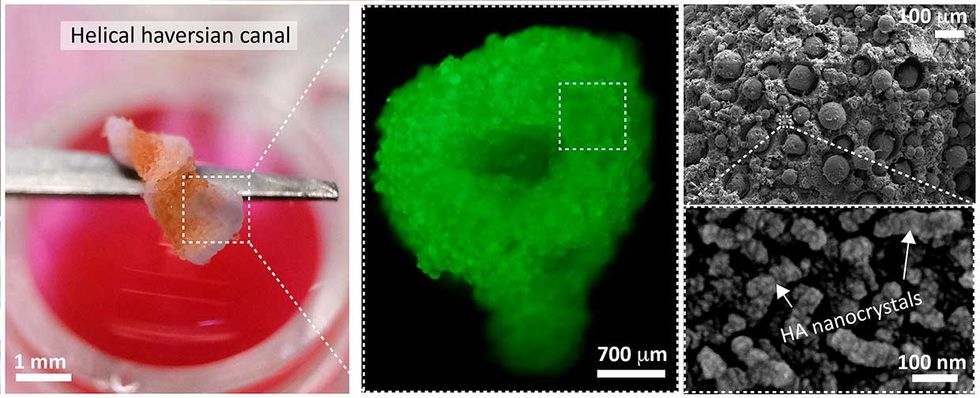3D printing living tissue—including corneas, blood vessels and skin—is no easy task. But at least it’s all living tissue. Bone, by contrast, is a mixture of living and inorganic compounds in a highly structured mineral matrix.
3D printing bone, in other words, is a challenge within a challenge.
Which is why bioengineers have tried so many different materials for their synthetic bones—including hydrogels, thermoplastics, and bioceramics. Now, a team at the University of New South Wales in Sydney, Australia, has developed a ceramic ink that can be 3D-printed at room temperature with live cells and without harsh chemicals—a notable improvement over earlier technologies. The new technique could eventually be used to print bone directly into a patient’s body, the researchers say.
“In contrast to previous materials, our technique offers a way to print constructs in situ which mimic the structure and chemistry of the bone,” says study co-author Iman Roohani, a bioengineer at UNSW's School of Chemistry. “The opportunities are limitless.” The work is described this week in the journal Advanced Functional Materials.
3D-printed bone tissue has plentiful medical and research applications: modelling bone disease; drug screening; studying bone’s unique microenvironment; and perhaps most notably, repairing damaged bone in cases of trauma, cancer or other illnesses. The current gold standard for repairing bone is an autologous bone graft—harvesting bone from another part of the patient’s own body. Unfortunately, autologous grafts are associated with high rates of infection and don’t work if the needed amount of bone material is too large.
In an effort to create a synthetic bone material as similar to an autologous graft as possible, Roohani, biochemist Kristopher Kilian and colleagues at UNSW made an ink that could be 3D printed into an aqueous environment like the body. After two years of refining, they created a biocompatible calcium phosphate material that forms a paste at room temperature. When put into a gelatin bath or other solution, a chemical reaction occurs and the paste hardens into a porous nanocrystal matrix similar to structure of native bone tissue.

To print with the ink, they equipped an off-the-shelf 3D printer, the Hyrel 3D Engine HR, with a custom nozzle. Small needles, from 0.2-0.8mm, extruded the ink into a 37ºC gelatin bath. The technique, called ‘COBICS’ for ceramic omnidirectional bioprinting in cell-suspensions, can be adapted to other 3D printers such as portable and handheld printers to be taken into a surgical room, says Roohani. “You’ll need to engineer the printer for each application, but the concept and the principle of the technique will be similar.”
In their recent paper, the team printed small bone structures, up to half a centimeter cubed, into a gelatin bath containing human bone-forming cells and other types of human cells. The hardening ink incorporated the living cells into the structure, and the cells adhered and proliferated for several weeks after printing with 95% viability.
The team is currently designing a bath to print larger samples and has begun small animal tests to see if a print can repair a large wound as effectively as an autologous graft. Next, Roohani hopes to work with surgeons, dentists and others to explore healthcare and research applications of COBICS, and pursue a path to regulatory approval. In the US, the FDA has already signaled that 3D-printed bone technologies are eligible for FDA clearance.
This article appears in the April 2021 print issue as “3D-Printing Bone Directly Into the Body.”
Megan Scudellari is an award-winning freelance journalist based in Boston, Massachusetts, specializing in the life sciences and biotechnology. She was previously a health columnist for the Boston Globe and has contributed to Newsweek, Scientific American, and Nature, among others. She is the co-author of a college biology textbook, “Biology Now,” published by W.W. Norton. Megan received an M.S. from the Graduate Program in Science Writing at the Massachusetts Institute of Technology, a B.A. at Boston College, and worked as an educator at the Museum of Science, Boston.



